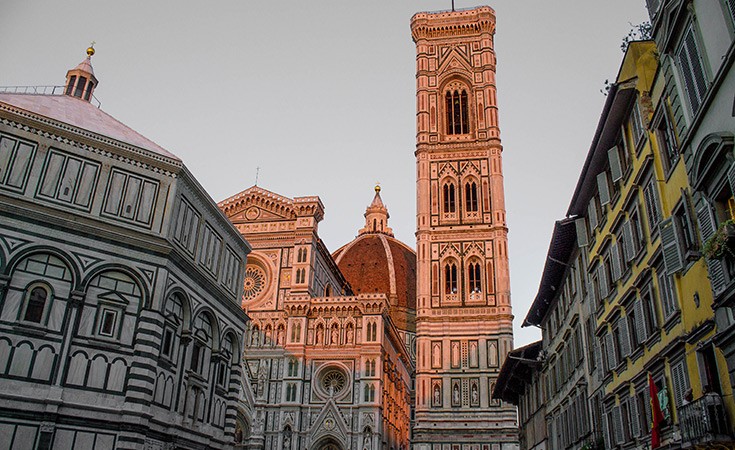
Giotto’s Bell Tower is one of the four main components of the Duomo Square in Florence. The tower itself is 84,7 meters tall and around 15 meters wide. It is the most magnificent example of Gothic Florentine architecture of the 14th century that, in spite of its vertical nature, doesn’t neglect the principle of firmness. Completed in white, red and green marble, much like the marble used for the Duomo Cathedral, this magnificent bell tower with a square base is considered the most beautiful in Italy, and it was possibly erected to serve a decorative rather than a funcional purpose. The bell tower was designed by artist Giotto di Bondone in 1334.
Because of the artist’s death, which happened in 1337, Giotto was only able to see the first phase of the project, to the level of the hexagonal slabs. His work was taken over by Andrea Pisano, who managed to complete the first two floors according to the original design that Giotto envisioned. The bell tower was decorated with external lozenges with certain work completed by Alberto Arnoldi. In the rich decorative complex of hexagonal lozenges, one can witness the concept of universal order and the history of Retribution. The statues themselves deserve to be explained, as they were intended to be integral parts of the very building rather than mere decorative pieces.
Andrea Pisano replaced the sixteen arches intended to contain statues of kings and Sybil and statues of the four Patriarchs and Prophets, the last two of whom were executed, another work by Nanni di Banco and Donatello, among which there is marvelous sculptural group called The Sacrifices of Isaac, which represents one of the most beautiful works of naturalism in fifteenth-century sculpture.
Between 1348 and 1350, work on the Campanille was halted, and the Campanille was finally completed in 1359, after the devastation caused by the plague ended. Francesco Talenti completed the tall windows which let a large amount of light to pass through the building, making the bell tower elegantly Gothic while still pertaining to the classical wholeness principles.
The large balcony, which is situated more than 400 steps above ground, serves the purpose of a panoramic roof. This is the last work of master Talenti, with which he rejected Giotto’s idea of a spiral roof.
Visitors should pay special attention to the relief on the Campanille representing medicine, which depicts the practice of uroscopy.
The view from the top of the Campanille is simply spectacular.
 Entrance fee for Giotto’s Bell Tower:
Entrance fee for Giotto’s Bell Tower:
Visitors must purchase a ticket online. The entrance to the complex has no ticket booth. The price of a cumulative ticket is €18
(!) A cumulative ticket includes a single pass for the following monuments: The Opera Santa Maria del Fiore Museum, Brunelleschi’s Dome, Giotto’s Campanilla, The Baptistery of St. John and the archeological site Santa Reparata.
(!) The ticket has a 72hr validity period. It covers one person.
(!) The reservation fee per person costs €2.
The website where you can purchase a ticket
https://operaduomofirenze.skiperformance.com/en/store#/en/buy
 Open hours for Giotto’s Bell Tower:
Open hours for Giotto’s Bell Tower:
The Campanille is open between 8:15am and 7:30pm
The Campanille is closed for visitors every first Tuesday of the month.